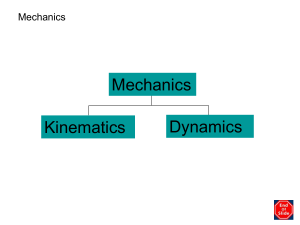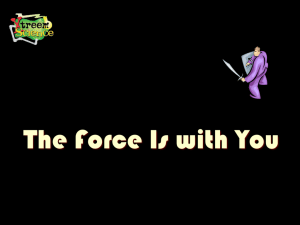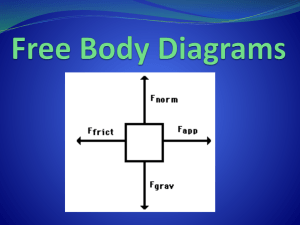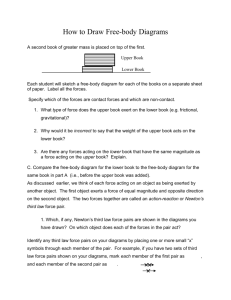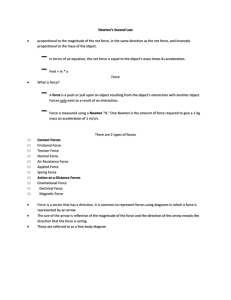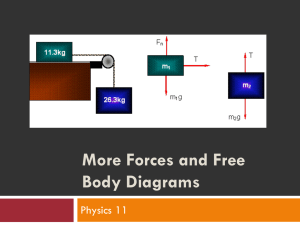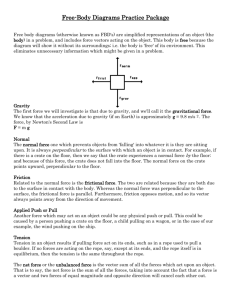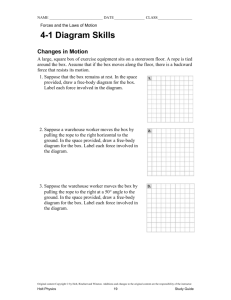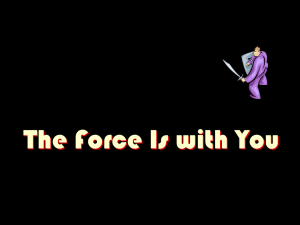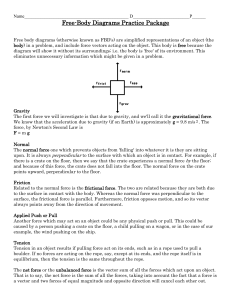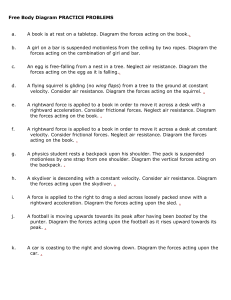What is a Force?
advertisement
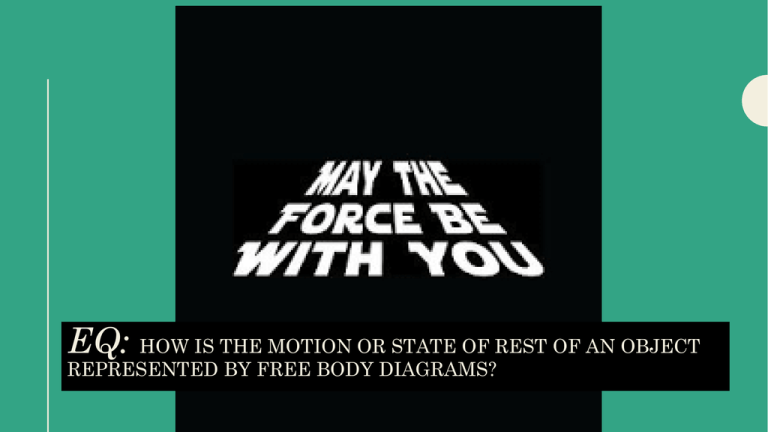
EQ: HOW IS THE MOTION OR STATE OF REST OF AN OBJECT REPRESENTED BY FREE BODY DIAGRAMS? WHAT IS A FORCE? A force is a push or pull upon an object resulting from the object's interaction with another object. It is a vector quantity. Whenever there is an interaction between two objects, there is a force upon each of the objects. When the interaction ceases, the two objects no longer experience the force. Forces only exist as a result of an interaction. T Y P E S O F F O R C E S Contact Forces Action-at-aDistance Forces Frictional Force Gravitational Force Tension Force Electrical Force Normal Force Magnetic Force Air Resistance Force Applied Force Spring Force Gravitational Force (Weight): Fg This is the only force that will always be present and will always point straight down. Tension Force : Ft This type of force is caused by a rope, chain, string, etc. and goes F Normal Force: O Applied Force: R Frictional Force: C Net Force: E S in the direction of the rope, chain, string, etc. Fn This type of force is present when the object is in contact with a surface. It always points perpendicular to the surface. Fa This type of force is used when an outside agent is acting on the object such as a person. Ff This type of force is the result of two surfaces being drug across each other, creating friction. It always points in the direction opposite of the movement. Fnet Sum of all forces *Vector: The size of the arrow should be proportional to the size of the force. Larger forces should have larger arrows!!! Arrow should represent direction of force. FREE BODY DIAGRAM FBD A physical representation that shows the forces acting on a system. Accelerations are the result of unbalanced forces. If a motion diagram show that an object is accelerating, a free body diagram of that object should have an unbalanced force in the same direction as the acceleration. FREE BODY DIAGRAM – ANALYZING FORCES A force is applied to the right to drag a sled across loosely packed snow with a rightward acceleration. Neglect air resistance. A free-body diagram for this situation looks like this: FREE BODY DIAGRAM a. A physics book rests upon a level table.. A free-body P r a c t i c e diagram for this situation looks like this: b. A flying squirrel is gliding (no wing flaps) from a tree to the ground at constant velocity. Consider air resistance. A free-body diagram for this situation looks like this: FREE BODY DIAGRAM c. A girl is suspended motionless from the ceiling by two P r a c t i c e ropes. A free-body diagram for this situation looks like this: d. An egg is free-falling from a nest in a tree. Neglect air resistance. A free-body diagram for this situation looks like this: CALCULATING NET FORCE In each of the above situations, there is an unbalanced force. Unbalanced force indicates object is accelerating (velocity is changing – slowing down, speeding up, changing direction) FIND THE NET FORCE P r a c t i c e Free-body diagrams for four situations are shown below. For each situation, determine the net force acting upon the object and the direction of acceleration. FIND THE NET FORCE P r a c t i c e A 2.0-kg bucket is tied to a rope and accelerated upward out of a well at a rate of 1.5 m/s/s. Neglect air resistance. Diagram the forces acting on the bucket. FBD: ΣFx = ma = (2.0)(0) ax = 0 ΣFy = ma = (2.0)(1.5) = 3.0 N 2 FT ay = 1.5 m/s Fg Find the individual forces acting on the bucket: FT = ____ Fg = ____
